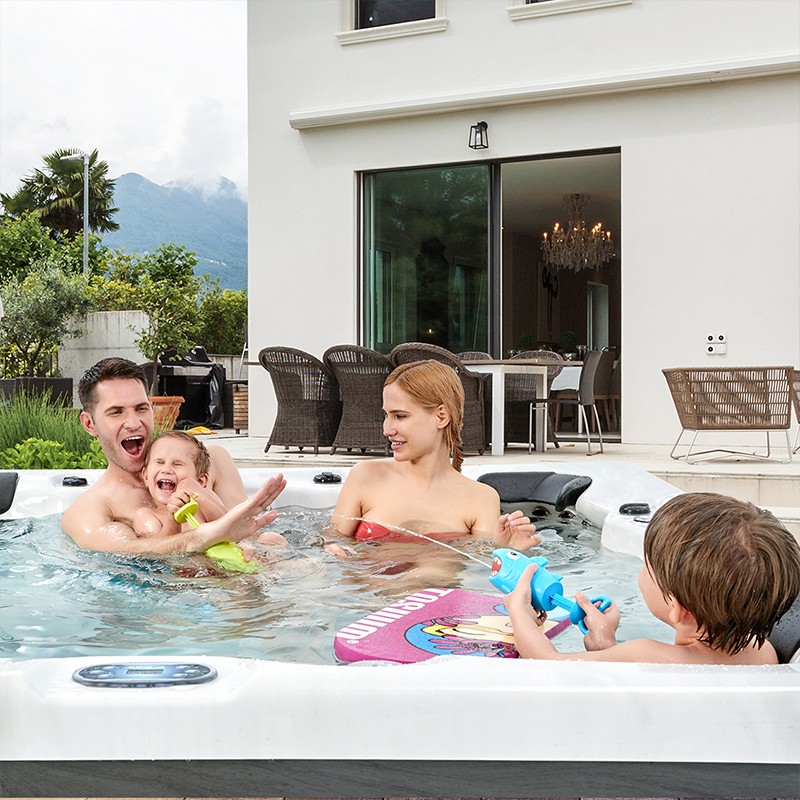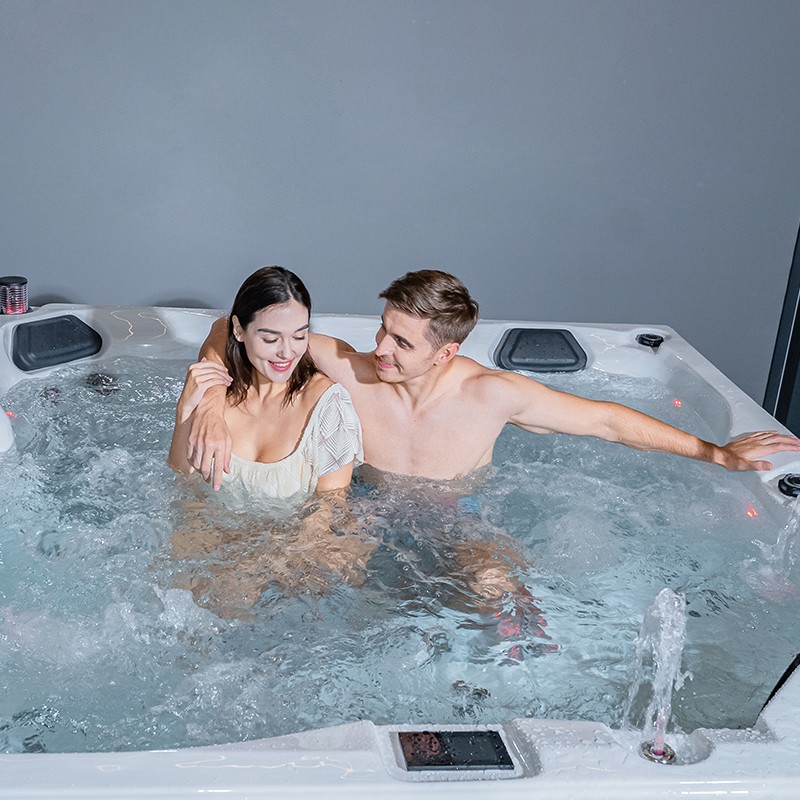
What should you add to your spa jacuzzi bathtub when it foams?
2025-11-29 15:35When relaxing and enjoying a comfortable bath, a thick layer of foam floating on the surface of your spa jacuzzi bathtub can instantly turn the pleasant experience unpleasant. Foam not only affects the visual appeal but may also indicate abnormal water quality or system imbalance.
So, what should you add when your spa jacuzzi bathtub foams?
This article will systematically analyze the causes of foam formation from multiple perspectives, including chemical principles, water quality balance, product selection, and usage methods, and will explain in detail how to properly handle and prevent foam problems.

Why does foam appear in a spa jacuzzi bathtub?
Foam formation is due to the interaction between air, water, and chemicals dissolved in the water.
When the spa jacuzzi bathtub is running, the nozzle continuously injects air into the water flow, creating bubbles. When the water contains surfactants, organic matter, or chemical residues, these bubbles are stabilized, eventually forming a thick layer of foam on the surface.
Common causes of foaming include:
1). Residual detergents or personal care products
Shower gels, shampoos, and skincare products all contain surfactants, which produce persistent foam when mixed with air.
2). Water imbalance (pH too high or alkalinity too high)
An incorrect water balance makes foam easier to form and harder to eliminate.
3). Accumulation of organic matter in the water
Oils, sweat, and dead skin cells react with chemicals in the spa jacuzzi bathtub water, producing bubbles.
4). Improper proportions of disinfectants or chemicals
Excessive chlorine or bromine can cause chemical imbalances, increasing foam stability.
5). Aging water
Excessive accumulation of dissolved substances in water that hasn't been changed for a long time can also increase foam production.
Therefore, the appearance of foam is not accidental, but rather a sign of problems with the water quality or maintenance of the spa jacuzzi bathtub.

Can I add an anti-foaming agent directly to the spa jacuzzi bathtub when it foams?
Many people's first reaction is to buy so-called "anti-foaming agents" or "defoamers" for spas, jacuzzis, and bathtubs. However, blindly using them is not the best solution.
1. How Anti-Foamers Work
Anti-foaming agents (Defoamer or Anti-Foam) work by altering the surface tension of water, disrupting the stable structure of air bubbles and causing them to dissipate quickly.
Common types of anti-foaming agents include:
• Silicone-based anti-foaming agents: fast-acting, suitable for high-temperature water;
• Polyether-based anti-foaming agents: environmentally friendly, suitable for frequent use;
• Composite anti-foaming agents: possess both defoaming and foam-suppressing functions.
2. Precautions for Using Anti-Foaming Agents
• Anti-foaming agents should be used as a "temporary solution," not a long-term necessity.
• Overuse can clog filters or cause water turbidity.
• Water quality should be tested after use to prevent chemical imbalances.
In other words, while adding anti-foaming agents is acceptable, it's more important to identify the root cause of foaming.
Besides anti-foaming agents, what else can be added to adjust the water quality of a spa jacuzzi bathtub?
1. pH Adjuster
When the pH value of the spa jacuzzi bathtub is too high, foam is more likely to form.
• The pH value should be maintained between 7.2 and 7.6.
• If the pH is found to be > 7.8, a small amount of pH reducer (pH Minus or pH Reducer) can be added.
2. Alkalinity Adjuster
High alkalinity in the spa jacuzzi bathtub (>150 ppm) can cause chemical agents to become ineffective, thus indirectly causing foam.
• The ideal range is 80–120 ppm.
• Total Alkalinity Reducer can be added to adjust alkalinity.
3. Enzyme Cleaner
These products can break down organic matter such as oils and emulsions in the spa jacuzzi bathtub water, reducing foam at its source.
• It is recommended to add a small amount once a week.
• Can be used with a filtration system to improve water purity.
4. Clarifier
Clarifiers help fine impurities aggregate into larger particles, making them easier for the filtration system to remove.
• Can help reduce the likelihood of foam formation.
• Use separately from antifoaming agents to avoid chemical interactions.
Therefore, when a spa jacuzzi bathtub foams, it's not enough to just add one substance; you need to adjust the pH, alkalinity, disinfectant, and organic matter content.

What are the correct steps for adding spa jacuzzi bathtub antifoaming agent?
Even if you decide to use spa jacuzzi bathtub antifoaming agent, you need to follow the correct operating procedures.
1. Turn off the jet system
Before adding antifoaming agent, turn off all water flow and aeration functions of the spa jacuzzi bathtub to allow the foam to stabilize on the surface.
2. Evenly Distribute the Antifoaming Agent
Pour the antifoaming agent evenly onto the surface of the spa jacuzzi bathtub according to the instructions (usually 10-30 ml per 1000 liters of water).
3. Wait for the Reaction
Let it stand for about 3-5 minutes and observe whether the foam has significantly decreased.
4. Restart the System
Start the spa jacuzzi bathtub nozzles and circulation pump to ensure the agent is thoroughly mixed and prevent excessively high local concentrations.
5. Check Water Balance
Use test strips to check the pH and chlorine levels, and adjust as necessary.
With proper operation, the antifoaming agent can eliminate foam within minutes, restoring the spa jacuzzi bathtub to clarity.
What substances should "absolutely not be added" when foaming?
Some spa jacuzzi bathtub users try to quickly eliminate foam by adding household vinegar, alcohol, dish soap, or even bleach. These practices are incorrect.
The following substances must never be added:
• Dishwashing liquid or degreaser: Contains high levels of surfactants, which will exacerbate foaming.
• Vinegar or alcohol: Can disrupt the water balance and cause corrosion of metal parts.
• Bleach (containing chlorine bleach): High concentrations can damage skin and the filtration system.
• Undiluted strong acid or alkali cleaners: Can easily corrode nozzles, seals, and acrylic bathtub surfaces.
The correct approach is to always use chemicals specifically designed for spa jacuzzi bathtubs and strictly follow the instructions.
Does foaming mean the spa jacuzzi bathtub needs a water change?
In some cases, yes.
If foaming is frequent and anti-foaming agents are ineffective, it may mean the spa jacuzzi bathtub water is "aged."
Criteria for determining if a water change is needed:
• Water used for more than 3–4 weeks;
• Repeated pH and alkalinity imbalances;
• Thick foam layer with an unpleasant odor;
• Anti-foaming agent's effect lasts no more than 24 hours.
In these cases, you should:
• Drain 80%–100% of the old water;
• Clean the filtration system and nozzles;
• Refill with fresh water and adjust the water quality.
Regular water changes not only prevent foaming but also extend the lifespan of your spa jacuzzi bathtub.

How to fundamentally prevent foaming in your spa jacuzzi bathtub?
1. Maintain water balance
Use test strips regularly to keep pH, alkalinity, and chlorine levels within the normal range.
2. Cleanse your body before use
Shower before entering the spa jacuzzi bathtub to remove skin oils and makeup residue.
3. Limit bath products
Do not use shower gel or scented bubble bath products in the bathtub.
4. Clean the filter regularly
It is recommended to clean the filter cartridge weekly and replace it every 3 months.
5. Use an enzyme solution monthly for maintenance
This effectively breaks down grease and organic matter, keeping the water pure.
6. Control the number of users and the duration of use
Frequent use or multiple people entering at the same time will increase the pollution load in the water.
Why does foam reappear after using anti-foaming agent?
Anti-foaming agents only use physical methods to break up foam and cannot fundamentally eliminate the source of foam.
If foam reappears, it indicates that there are still chemical or organic pollutants inside the system.
Possible causes include:
• The filter cartridge was not thoroughly cleaned;
• The water contains stable foam compounds;
• Insufficient disinfectant concentration, leading to bacterial growth;
• Grease buildup in the pipes.
In this case, a complete cleaning and water replacement should be performed, and chemical indicators should be rebalanced.
Does disinfectant need to be added again after using anti-foaming agent?
Generally, anti-foaming agents do not directly affect the disinfectant concentration. However, if partial water replacement was performed during the defoaming process, the disinfection level should be retested.
Correct Procedure:
• First, test the chlorine or bromine content;
• If the concentration is below the recommended values (chlorine 1–3 ppm, bromine 3–5 ppm), add appropriate amounts;
• Wait 30 minutes before turning on the bubble system.
This ensures that the spa jacuzzi bathtub retains good sterilization and purification capabilities even after the foam dissipates.
What should be added when the spa jacuzzi bathtub foams?
In summary, when the spa jacuzzi bathtub foams, you can add substances scientifically according to the following steps:
1. First, add an antifoaming agent – to quickly remove surface foam;
2. Then test and adjust the pH, alkalinity, and chlorine level – to restore chemical balance;
3. Add a cleaning enzyme – to break down grease and organic matter;
4. If necessary, replace part or all of the water – to eliminate the source of foam at its root.
At the same time, never use household cleaning products or chemicals to replace professional agents. Only by following the correct water quality maintenance principles can the spa jacuzzi bathtub remain clear, healthy, and effective.
What materials and components make LOVIA SPA’s products high quality?
Every LOVIA SPA product is built using Aristech acrylic shells imported from the USA, Balboa control systems, and LX pumps for reliable performance. These components ensure durability, energy efficiency, and premium comfort. Our Factory combines these parts through advanced molding and testing technology. Buyers and distributors trust our company for long-lasting, high quality spas at Low price.
